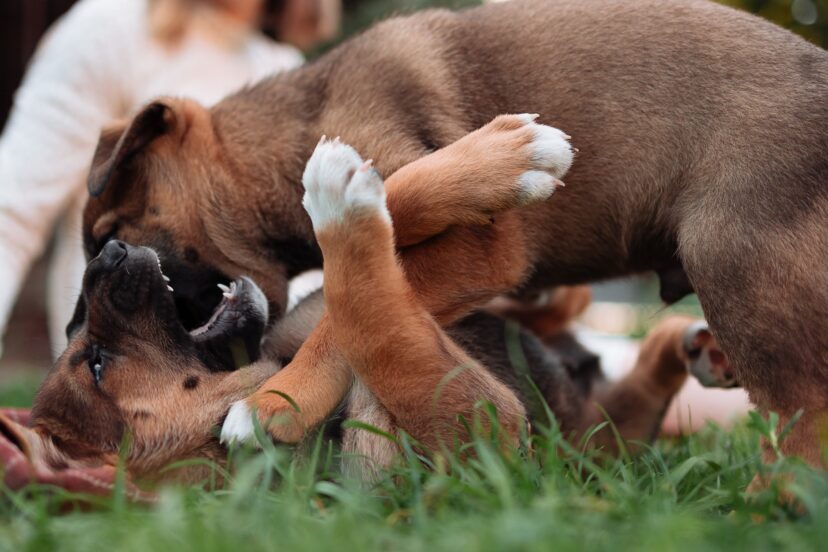Doggie Play: A Guide to Fun & Safe Playtime for Beloved Canines
Valuing my role as a dog parent, I wholeheartedly understand the importance of doggie play and recognizing what is appropriate, acceptable and safe. Dog play is a fun and enjoyable activity for our canine companions that serves several essential purposes. Dogs are social animals that thrive on interaction and play. Engaging in suitable play not only provides them with physical exercise but also promotes mental stimulation and socialization. By understanding the dynamics of dog play and learning to recognize signs of healthy interaction, we can create a positive and safe play environment for our beloved pets. In this article, I’ll delve into the world of dog play, explore its benefits, and discuss how to determine what is appropriate for our dogs.
Introduction
When dogs engage in play, it allows them to release energy, bond with other dogs or humans, and develop important social skills. However, not all play is suitable or safe. Understanding what constitutes appropriate dog play is crucial to ensure the well-being and happiness of our furry companions.
Understanding Doggie Play
Doggie play can be defined as any voluntary behavior that dogs engage in for recreational purposes. It is a natural instinctive behavior that allows dogs to learn and socialize by practicing important social skills, as well as burn off excess energy, and strengthen their physical and mental well-being. Activities such as chasing, wrestling, tug-of-war, and fetching are all aspects of dog play. Through play, dogs establish and maintain social hierarchies, learn boundaries, and develop impulse control. Play serves as a means of communication, exercise, and problem-solving for our canine friends. It is important to differentiate between play and aggression, as inappropriate play can escalate into dangerous situations.
Benefits of Appropriate Doggie Play
Engaging in appropriate play provides numerous benefits for dogs, including:
- Socialization: Play allows dogs to interact and communicate with other dogs and humans, helping them develop social skills and establish bonds and appropriate boundaries.
- Physical Exercise: Playful activities keep dogs physically active, promoting cardiovascular health, muscle development, and weight management, reducing the risk of obesity-related health issues.
- Mental Stimulation: Play stimulates a dog’s mind, challenging their problem-solving abilities and preventing boredom, which may lead to destructive behaviors.
- Emotional Outlet: Playful interactions release endorphins in dogs, promoting feelings of happiness and reducing stress and anxiety.
Types of Doggie Play
Dog play can take various forms, depending on the individual dogs and their preferences and play style. Some common types of dog play include:
- Chase and Tag: Dogs engage in chasing and being chased by their playmates. This mimics natural predatory behavior, a dogs’ natural instinct to hunt and can be a fun game for them.
- Tug-of-War: Dogs playfully tug on a toy or rope, engaging in a friendly competition. This game can be a great outlet for a dog’s natural prey drive. It is important to establish rules and boundaries to prevent it from becoming too rough or competitive.
- Wrestling: Dogs engage in physical play-fighting, using their bodies and mouths to interact. Playful wrestling allows dogs to practice their physical coordination and social skills. It usually involves gentle biting and tugging.
- Fetch and Retrieve: Dogs enjoy chasing and retrieving objects, such as toys or balls, showcasing their retrieving instincts. It provides both mental and physical stimulation.
- Interactive Toy Play: Dogs engage with puzzle toys, treat-dispensing toys, or interactive games to stimulate their problem-solving skills.
Understanding the different types of play helps us cater to our dog’s preferences and provide them with suitable play opportunities.
Signs of Appropriate Doggie Play
Identifying signs of appropriate dog play is essential to ensure a safe and enjoyable experience. To determine whether a dog’s play is appropriate, it’s important to observe their body language and behavior. Dogs exhibit specific indicators when engaging in healthy and enjoyable play.
Body Language and Behavior Indicators
- Relaxed Body Posture: Dogs engaged in appropriate play display loose and relaxed body postures, with wagging tails and open mouths.
- Equal Give-and-Take: Dogs take turns being the “chaser” and the “chased,” ensuring a fair and balanced play dynamic.
- Play Bows: Dogs often initiate play by performing a play bow—a forward stretch with their front legs and lowered front end—signaling their intent to play.
- Soft Barking or Playful Vocalizations: Dogs may emit soft barks, growls, or playful vocalizations during play to communicate their enjoyment. These are typically friendly and not aggressive.
Positive Interactions Between Dogs
During appropriate play, dogs interact positively with each other, displaying friendly behaviors such as:
- Role Reversal: Dogs take turns being on top during wrestling or play-fighting, demonstrating fairness and respect.
- Body Checks: Dogs engage in gentle body checks, bumping into each other without causing harm.
- Shared Toys: Dogs willingly share toys or take turns playing with them, without showing possessive or aggressive behavior.
- Self-Interruption: Dogs pause or stop play momentarily to offer calming signals, such as turning their heads or taking a break, if play becomes too intense.
Recognizing these signs of appropriate play helps us ensure that our dogs are enjoying their playtime and maintaining healthy interactions.
Factors Influencing Appropriate Doggie Play
Several factors influence what is considered appropriate play for dogs. It’s important to consider these factors when evaluating your dog’s play habits.
Dog’s Age, Size, and Breed
A dog’s age, size, and breed can influence their play preferences and style. Puppies, for example, have high energy levels and may engage in more boisterous play. Small dogs may prefer gentler play, while larger dogs may engage in more physical interactions. Breed characteristics can also influence play styles, such as herding breeds instinctively nipping at heels during play.
Energy Levels and Play Styles
Each dog has unique energy levels and play styles. Some dogs may have a higher play drive and require more active play sessions, while others may prefer calmer play interactions. Understanding your dog’s energy levels and play style helps ensure they receive appropriate play opportunities.
Socialization and Previous Experiences
A dog’s socialization and previous experiences play a crucial role in their play behavior. Well-socialized dogs that have had positive interactions with other dogs are more likely to engage in appropriate play. Dogs with limited socialization or negative experiences may display fear, anxiety, or aggression during play.
Supervising Doggie Play
While dogs can engage in play without constant supervision, it is crucial to monitor their interactions, especially when introducing new dogs or in multi-dog households. Keep an eye on their body language and intervene if play escalates into aggression or if one dog becomes overwhelmed or stressed. Interrupting play periodically for short breaks can prevent overstimulation and exhaustion.
As responsible owners, it’s our duty to supervise our dogs’ play and create a safe and controlled environment.
Role of the Owner
Owners play a vital role in supervising dog play. Here are some key responsibilities:
- Observation: Pay close attention to your dog’s behavior and the behavior of their playmates to ensure a positive play environment.
- Intervention, if Necessary: If play becomes too rough or inappropriate, intervene calmly to redirect the dogs’ behavior and create a more suitable play dynamic.
- Knowing Your Dog’s Limits: Understand your dog’s tolerance and energy levels. If your dog seems overwhelmed or tired, provide them with a break.
Ensuring a Safe and Controlled Environment
To ensure the safety of your dog and others, consider the following:
- Appropriate Space: Choose a safe and enclosed area for play to prevent dogs from wandering off or encountering hazards or danger.
- Compatibility: Match your dog with suitable playmates of similar size, energy level, and play style.
- Supervision: Stay nearby and actively monitor the play session, intervening if necessary.
Creating a safe and controlled play environment allows dogs to engage in appropriate play while minimizing potential risks.
Encouraging Appropriate Doggie Play
To encourage appropriate dog play, we can take proactive steps to provide our dogs with suitable play opportunities and stimulate their natural instincts.
Choosing Suitable Playmates
When arranging playdates or visits to the dog park, consider the following:
- Temperament: Select playmates that have compatible temperaments and play styles.
- Similar Energy Levels: Match your dog with playmates of similar energy levels to ensure a harmonious play experience.
- Supervised Introductions: Allow dogs to meet and interact in a controlled and supervised manner before engaging in off-leash play.
Providing Appropriate Toys and Activities
Engage your dog in stimulating play by providing suitable toys and activities:
- Interactive Toys: Offer puzzle toys, treat-dispensing toys, or interactive games that challenge your dog’s problem-solving abilities and keep them mentally engaged.
- Variety of Toys: Provide a variety of toys to cater to different play preferences, such as tug toys, balls, and plush toys.
- Structured Playtime: Set aside dedicated playtime with your dog, engaging in activities such as fetch, tug-of-war, or hide-and-seek.
By choosing suitable playmates and providing engaging toys and activities, we can ensure that our dogs have fulfilling and appropriate play experiences.
Intervening in Inappropriate Doggie Play
Occasionally, dogs may engage in inappropriate play behaviors that require intervention to maintain a safe and enjoyable play environment.
Identifying Warning Signs
Watch for these warning signs of inappropriate play:
- Intense Aggression: Growling, snarling, or biting that goes beyond normal play behavior.
- Fearful Reactions: Signs of fear or distress, such as cowering, hiding, or excessive submissive behaviors.
- Persistent Bullying: One dog consistently dominating or relentlessly chasing another dog, causing distress.
- Overwhelmed Behavior: A dog appearing overwhelmed, seeking to escape or showing signs of stress, such as excessive panting or pacing.
Redirecting and Managing Behavior
If you notice any of the above signs or feel that play is becoming inappropriate, take the following steps:
- Distraction: Divert the dogs’ attention by introducing a new toy or engaging them in a different activity.
- Time-Out: Separate the dogs temporarily to allow them to calm down and reset their energy levels.
- Reintroduction: If the dogs were temporarily separated, reintroduce them gradually to assess whether play can resume in a positive manner.
By intervening and redirecting inappropriate play, we can promote a safe and enjoyable play environment for all dogs involved.
Conclusion
Appropriate dog play is vital for the overall physical well-being and mental happiness of our canine companions. Understanding the different types of play, recognizing signs of healthy interaction, and considering factors such as age, size, and play style helps us provide suitable play opportunities that are safe and stimulating. Remember to observe their body language, supervise interactions, and tailor play sessions to their individual needs. By supervising play, creating a safe environment, and encouraging positive play habits, we foster strong bonds with our dogs while ensuring their physical, mental, and emotional needs are met, promoting a healthy and happy lifestyle.




